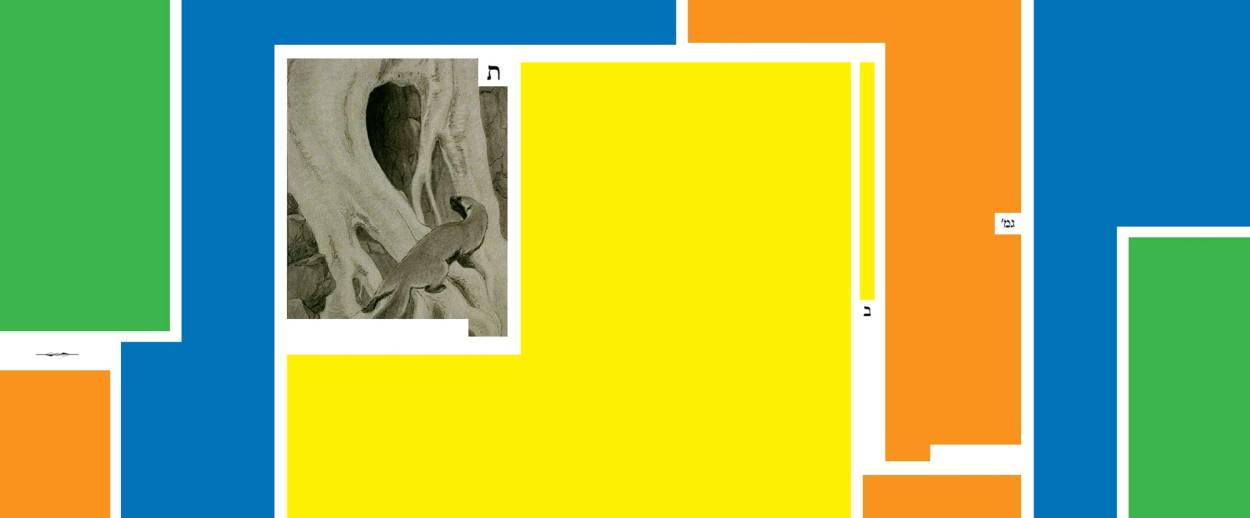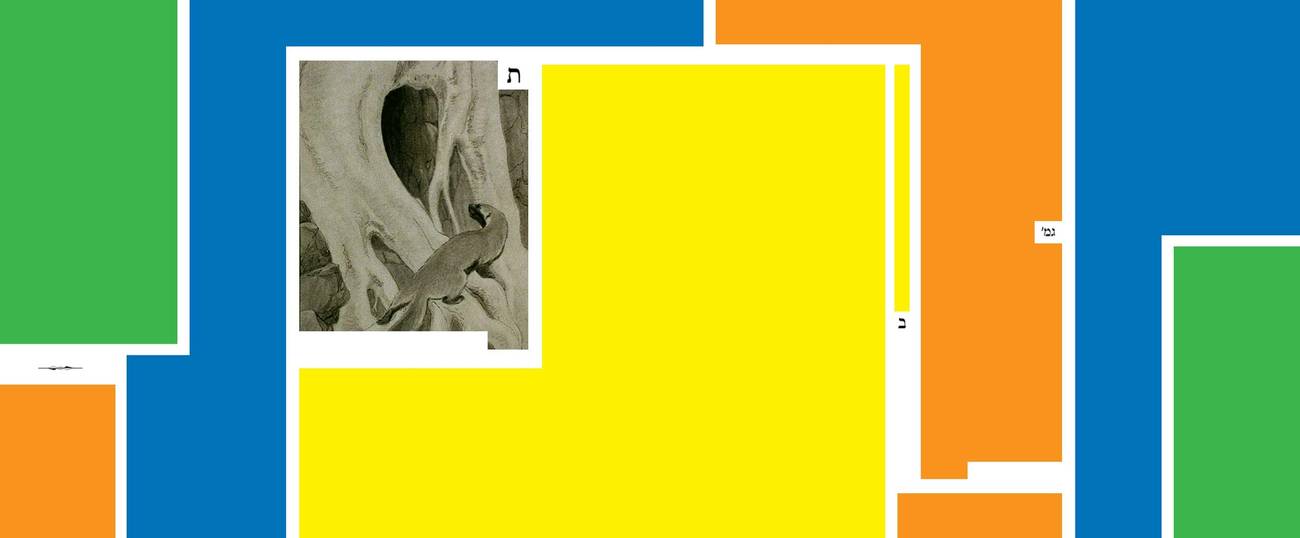Womb Raider
In this week’s ‘Daf Yomi,’ Talmudic rabbis imagine a situation involving a weasel, a cow’s womb, a fetus, vomit, and a firstborn calf. Naturally.




Literary critic Adam Kirsch is reading a page of Talmud a day, along with Jews around the world.
American lawyers have a saying that “hard cases make bad law.” Laws are supposed to be framed broadly and clearly, stating rules that can be applied in the majority of cases; but there will always be a few problems that are so complicated and unusual that it’s hard to apply the usual rules. The saying suggests that it’s better to let those exceptions stand as exceptions, rather than twist the rule so that it will cover every possible contingency.
One of the things that can make Talmudic reasoning feel so foreign is that the rabbis take exactly the opposite approach. They love hard cases; in fact, they will frequently invent hypothetical situations that are improbable and convoluted, precisely in order to test the outer limits of legal concepts. When people use the word “Talmudic” to describe reasoning that is overly complicated and detached from the real world, it is this kind of hypothetical argument that they have in mind.
Over the course of my Talmud study, a few such examples have stuck with me because of their sheer weirdness. For instance, the rabbis asked in Tractate Sukkah if it is permitted to use an elephant as one wall of a sukkah. (The answer is yes, provided it’s a dead elephant, since a living one might walk away.) This week’s Daf Yomi reading, in Chapter 4 of Tractate Chullin, featured a similarly bizarre thought experiment. In Chullin 70a, the rabbis imagine a situation in which a weasel climbs into the womb of a cow that is pregnant for the first time, swallows the fetus, crawls out of the womb, then reenters it and vomits the fetus out, and then the fetus is born naturally. In this case, they ask, is the calf considered a firstborn animal for the purposes of tithing?
It’s safe to say that in the entire history of the Jewish people, this series of events has never happened. Indeed, the notes to the Koren Talmud explain that the commentaries grant the situation is impossible; the reason the rabbis invented it was to obey the commandment “Expound on new understandings of Torah and receive reward.” Talmudic study and legal reasoning are inherently meritorious activities, and the rabbis love to engage in them for their own sake, even when they’re not trying to solve a real-world problem.
Rather, such rabbinic thought experiments are designed to test the borderline between different concepts and categories. In this case, the question the rabbis are thinking about is how to define a firstborn offspring, which is important because the firstborn of every animal is supposed to be sacrificed to God. As Exodus 13:2 says, “Consecrate to Me every firstborn, that which opens the womb.”
This language suggests that what defines a firstborn child is that it “opens” the mother’s womb for the first time. But is it possible, the rabbis wonder, for a child to be born without actually opening its mother’s womb? Is physical contact between the child and the walls of the birth canal required to open the womb in a legal sense? It is to test this idea that the rabbis offer up a series of hypotheticals. “Rava raises a dilemma: If one wrapped the fetus in the bast of a palm tree while it was still in the womb, what is the halacha?” What if a midwife reached into the womb and pulled the baby out in her hands? Indeed, what about the afterbirth that usually surrounds a baby when it is born—doesn’t this interpose between the child and the flesh of the mother, so that it is technically the afterbirth, rather than the child, that “opens” the womb?
It is in the course of this argument that Rava imagines the case of a weasel that enters a cow’s womb and absconds with the fetus. In this case, the fetus emerges from the womb without touching its opening, since it is concealed inside the weasel’s stomach. If “the weasel brought it out,” the Gemara says, the child is not considered to have opened its mother’s womb, and it can’t be considered a firstborn offspring. Then the Gemara adds another wrinkle, imagining that the weasel reenters the womb and vomits out the fetus so that it can be born normally. In that case, the child has actually exited the mother’s womb twice, once inside the weasel and once in the normal way. So which exit is considered its actual birth?
Nor is this the end of the Talmud’s imaginative inquiry. What would happen if “one pressed together the openings of two wombs of two animals giving birth to firstborns, and a fetus exited from the womb of this animal and entered the womb of that animal, and then emerged from the womb of the second animal, after which the second animal gave birth to its fetus”? Is the second fetus to emerge considered a firstborn child, or do we say that the womb of the second animal had already been opened by the fetus that crawled into it from the first animal?
Taken literally, this sounds preposterous, and the Gemara responds to the problem as it often does with very hard cases: teiku, “it shall stand” unresolved. But this is a good example of how the Talmud’s conceptual inquiries can prove to be useful in ways that the rabbis themselves could not have anticipated. After all, this is really a debate about what defines birth and parentage: Is it the relationship between the mother and the child, or is it the physical act of emerging from the mother’s womb? And while these issues might have seemed abstract in the year 400 CE, today they are at the cutting edge of debates about surrogacy and in vitro fertilization, which involve a fetus “migrating” from one womb to another.
Then there is the related issue of abortion, whose place in Jewish law is very different from the way it is thought about by, for instance, Catholics. Earlier in Chapter 4 of Tractate Chullin, the rabbis analyze a situation where a pregnant cow is slaughtered and its dead fetus is extracted. Is the calf considered an independent being? If so, it cannot be eaten, because Jewish law does not allow eating the carcass of a dead animal; it would have to be slaughtered to be kosher, and it is impossible to slaughter a calf that is already dead. But if it is considered a part of its mother’s body, then it can be eaten, because it would be validated by the kosher slaughter of its mother.
In this case, it all turns out to depend on whether any part of the fetus emerges from the womb during the slaughtering process, since that helps to determine when it is technically “born.” But the whole debate has obvious implications for the law of abortion, since it raises the issue of when a fetus is considered an independent life. It turns out that the Talmud’s hard cases, weird as they sometimes seem, can turn out to be crucial in the real world.
***
Adam Kirsch embarked on the Daf Yomi cycle of daily Talmud study in August 2012. To catch up on the complete archive, click here.
Adam Kirsch is a poet and literary critic, whose books include The People and the Books: 18 Classics of Jewish Literature.